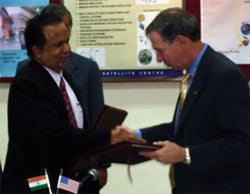India’s inaugural mission to the Moon is scheduled to launch in early 2008. When India launches its unmanned Chandrayaan-1 mission, two NASA instruments will be aboard: the Moon Mineralogy Mapper and the Miniature Synthetic Aperture Radar. The Chandrayaan-1 mission also marks NASA’s first partnership with India.
NASA Administrator Michael Griffin and Indian Space Research Organization Chairman G. Madhavan Nair agreed to conduct research together and signed two Memoranda of Understanding in Bangalore, India, May 9. “It is my hope and belief that as we extend the reach of human civilization throughout the solar system, the United States and India will be partners on many more technically challenging and scientifically rewarding projects,” said Griffin at a ceremony held in Bangalore after the signing.
M3’s orbit will cross the Moon’s poles at a height of 62 miles (100 kilometers). The instrument’s 25-mile (40 km) field of view will provide two types of high-resolution images: global images with about 459-foot (140 meters) resolution and targeted images with about 230-foot (70m) resolution.
The Miniature Synthetic Aperture Radar (miniSAR) is the second instrument NASA will supply for India’s Moon mission. MiniSAR will search for ice deposits near the lunar poles. MiniSAR weighs less than 30 pounds (14 kilograms).
The European Space Agency (ESA) will support three Chandrayaan-1 mission instruments — an X-ray spectrometer, the SARA atom reflecting analyzer, and the SIR-2 near-infrared spectrometer — that are identical counterparts to its SMART-1 mission. ESA will also provide hardware support for the High-Energy X-ray (HEX) spectrometer.
The U.S. won’t return to the Moon until 2018, so collaborating with India on its 2008 Chandrayaan-1 mission will provide an opportunity to continue research on our nearest neighbor.










